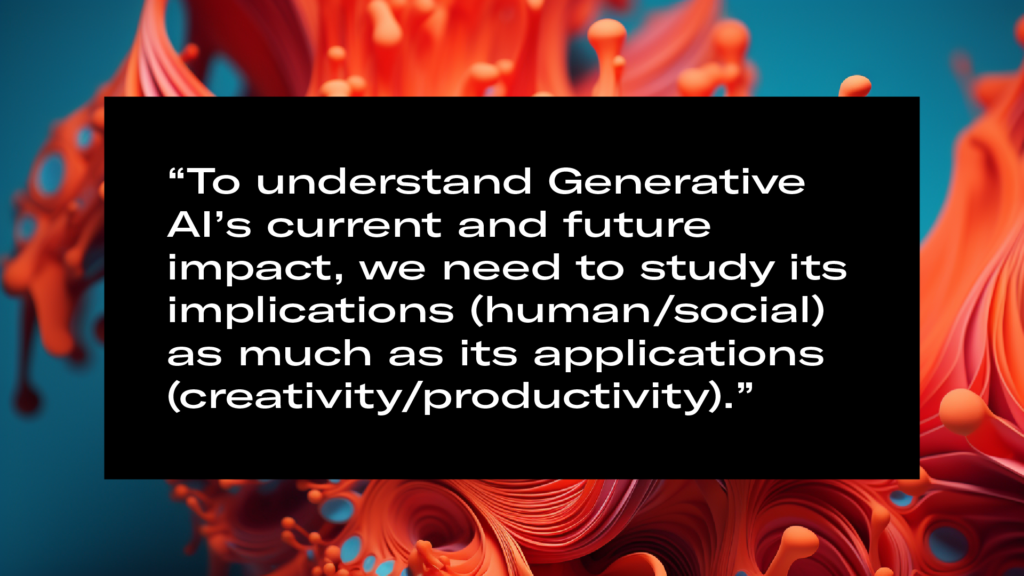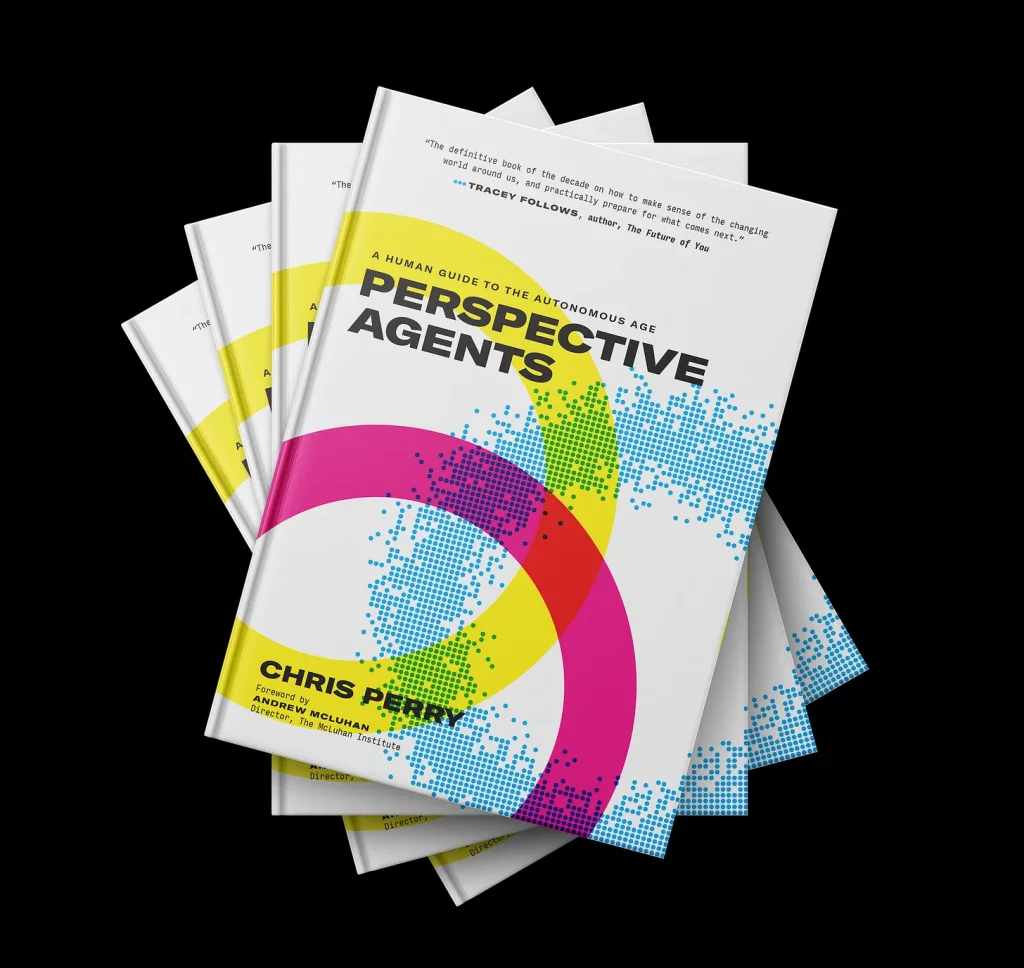One of the first casualties of Generative AI is the annual trend report. Not because LLMs are more adept at predicting future trends, but because the value of trendspotting declines facing a breakdown in conventions and a maelstrom of shifting cultural currents. This newsletter delves into the disintegration of norms, cultural turbulence confusing us, and a new book that can help us better decode what’s in store. This post is adapted from the introduction of Perspective Agents, my new book, posted on Substack.
Johannes Gutenberg’s printing press, dating back to the 15th century, was a seminal moment in Western civilization. This marvel accelerated the diffusion of ideas that sparked historic social transformations, including the Reformation (theology), the French Revolution (political order), and the Industrial Revolution (economics).
In 1900, Mark Twain wrote, “Gutenberg’s achievement created a new and wonderful Earth, but also at the same time a new hell. During the past 500 years, Gutenberg’s invention supplied earth and hell with new occurrences, new wonders, and new phases.” It’s worth noting Twain also famously said, “History doesn’t repeat itself, but it often rhymes.”
Twain’s words are relevant to a historic turning point. This year, AI moved into the mainstream. It’s been presented as mankind’s greatest feat (leading to unprecedented human prosperity) and last invention (accelerating the end of humanity).
Visionaries like Kevin Kelly (founding editor, Wired) and titans like Sundar Pichai (CEO, Google) liken its influence to electricity and fire. When describing AI, Kelly suggests that the unfolding impact of an “autonomous age” will reveal itself over generations.
We can’t predict with certainty if AI is a prosperity-builder or an agent of doom. We can look more closely at current uses and effects and extrapolate from there.

In the near term, my strong sense is that the influx of artificial intelligence—and derivatives like generative AI—will push us further into a place of instability and confusion. To understand its current and future impact, we need to study the implications (human/social impact) as much as the applications (creativity/productivity impact).
Social impact spans new forms of conflict, contagion, polarization, political maneuvering, and emotional states. Consider the year’s biggest stories coming to a crescendo this month.
- Social conflict. The risk of civil conflict escalated this year. We’ve witnessed 630+ mass shootings in America and counting. According to CNN’s tracker, 29 took place on college campuses; 51on K-12 school grounds. Despite ongoing tragedies, there are no material changes to gun laws. 46% percent of Americans own firearms. Experts are increasingly worried unregulated social media algorithms increase the threat of a civil war.
- Contagion. An extraordinary intelligence oversight led to the barbaric murder of Israeli citizens. The ripple effects transcend a kinetic war on the ground. Information wars rage alongside military conflict. Public response led to a surge in anti-semitism and mass protests defending inhumane acts. Following congressional testimony, UPenn President Liz Magill resigned. Others face continued scrutiny. TikTok, an AI-powered platform, is now a major front shaping public opinion on the war and beyond. According to a recent YouGov/Economist poll, 20% of respondents aged 18-29 think that the Holocaust is a myth.
- Polarization. An ex-president with 91 federal indictments leads the Republican field by a 51% margin. Both sides argue the 2024 election is material to the sustainability of American democracy. 52% percent of Biden supporters say those who support Republicans are a threat to American life. 47% of Trump supporters say the same about Democrats. In a future shaped by personalized media, the truth won’t matter.
- Contested power. Elon Musk’s mission is to safeguard against potential extinction events and ensure our long-term survival – and he’s building companies of the future spanning transportation, clean energy, satellite internet, space exploration, and AI. Yet, he’s under heavy fire from public officials and the media. Adversaries distort his agenda, preying on inflammatory statements and personal flaws through memes tailor-made for algorithmically driven social networks.
- Emotional resilience. Taylor Swift became the first artist to win Time Magazine’s Person of the Year. Swift is the first and only musician to monopolize the Hot 100’s top 10 and place as the Billboard year-end, number-one artist in three decades (2009/2015/2023). Her mass appeal is attributed to a virtual army of supporters who follow her every move. Some equate her fandom—which will add $5.7 billion to the U.S. economy this year— to a living, breathing metaverse. Despite world-altering developments from power-wielding men like Trump, Netanyahu, and Musk, Time editors chose Swift because she became “the main character of the world.”
There’s a connection between these disparate storylines. Civil conflict, intelligence failures, social movements, cult-like beliefs, and cultural juggernauts are propelled by media technologies. While algorithms shaping dissent aren’t new, AI’s ability to mass-produce personalized content will fuel near-term instability.
Discerning the Impact of Structural Change
Echoing discord entering the print era, the rise of digital connectivity and artificial intelligence will create structural and social change. This year’s headlines are a case in point.
The transition affects our perception, potential, and agency. In War and Peace in a Global Village, Marshall McLuhan said conflict is a quest to protect identity and personal beliefs; technological innovations always threaten identity. When our place in the world is under threat, we fight. This understanding isn’t universally shared or recognized.
Norbert Wiener, a distinguished figure in computing and the architect of cybernetics, also warned about human agency entering an age dominated by AI. He cautioned that as our environment undergoes radical transformations, we must alter ourselves to survive and flourish in these new conditions.
Developing a forward-leaning, nuanced perspective is necessary to navigate social discord caused by new technologies. New sources – encompassing human insight and artificial intelligence – will help us through this turning point.
Perspective Agents will hit bookstores on January 15th. It shows how we’ve begun transitioning into a new age. While writing this book over the last three years, I absorbed insights and experiences from those building AIs, innovators using them for breakthroughs, and philosophers contemplating their impact. The research continuously reshaped my thinking about AI and its impact on our future.

This book isn’t a finite composition of rules or explicit answers to hard questions. It explores ways to better make sense of the structural change in progress and unthinkable events it causes. It’s designed to surface new questions for you.
One absolute carried through its development is the conviction that we must widen our lens. While writing, I was continually reminded of an enduring lesson from Thomas Kuhn, an American historian and philosopher of science.
Kuhn said revolutionary changes brought about through new technologies “involve discoveries that cannot be accommodated within the concepts in use before they were made.” He called revolutionary breaks in convention “paradigms.” Paradigmatic breaks reshape every aspect of how we think about the world.
As you will discover in the book, it’s possible to find order behind the disorder. Drawing from past and recent case studies, you will see how social transitions form through a cascading series of stages. Seeing change through this pattern helps anticipate what’s to come, interpret shifts with greater clarity, and adapt to new realities. Along these lines, the book’s trajectory follows a cyclical path.
Cycle one outlines perspectives in transition. This is about changes in how we think. The starting point of human change is an alteration of sensibilities. History shows that hardwired worldviews and beliefs begin to break down during disruptive eras. Making sense of events through outdated frames clouds confidence and judgment. Questions of self-preservation arise. Conflict escalates. The faster we alter our perspectives and see new realities, the more agency we gain.
Cycle two covers beliefs. This influences how we behave. The predominant technologies of an era shape new values, norms, and behaviors. Changes in sensibility lead to changes in belief. Here, I explore how people redefine their sense of self, seek meaning, find love, and deal with disruptions to their daily lives
Cycle three explores leadership. This is about what we can do. As new norms and behaviors take hold, they lead to structural change, creating opportunity and risk simultaneously. This section is about action, featuring new models, case studies, and possibilities for prosperity and well-being.
In total, Perspective Agents is a guide to contemplate new complexities — and opportunities— during an AI-induced Renaissance period. Just as the printing press reshaped society half a millennium ago, today’s technological revolution will demand a similar recalibration of perspective and action.
I hope Perspective Agents can be a useful provocation and guide to an uncertain, opportunistic, and high-stakes transition in progress.
-Chris Perry


